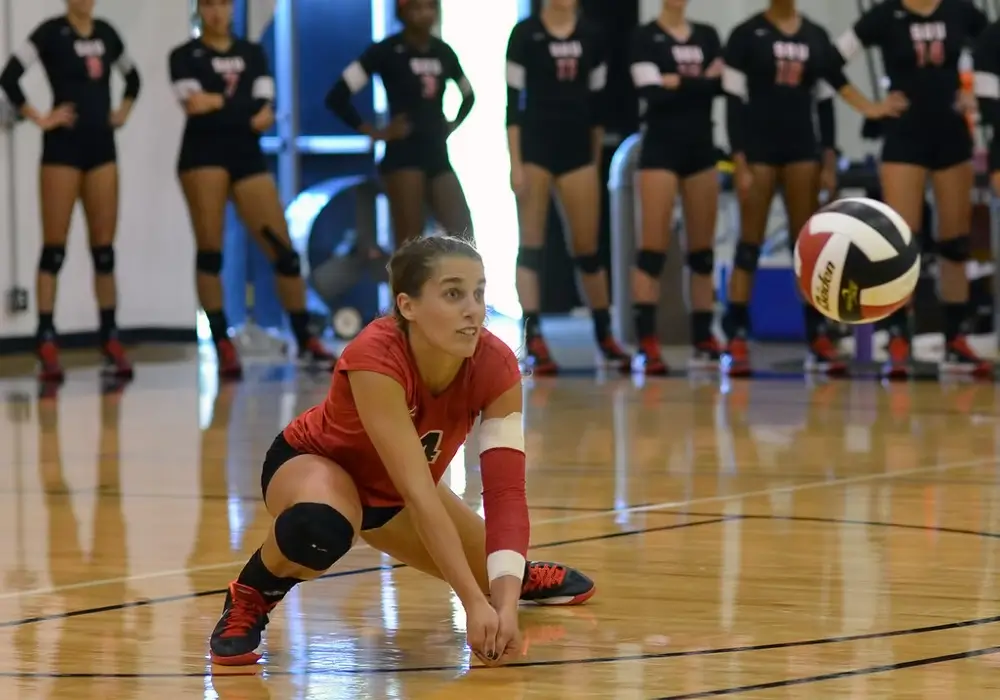Last Updated: January 16, 2024
Digging is one of the most important skills in the game of volleyball. However, most players often get it wrong resulting in poor play and numerous missed opportunities.
What can you do to make your digging game even better? What are some of the common mistakes to avoid?
I break down some key mistakes along with some strategies needed to up your game.

Poor Footwork
The best way to dig in volleyball is to have your feet planted on the ground. The feet should be shoulder-width apart and your knees slightly bent. One should be ready to react quickly though.
However, more often than not, players adopt poor footwork and this contributes to eventual poor digs.
Some of the most common footwork mistakes you can make during a volleyball dig include:
- Total lack of foot coordination
- Being off balance when contacting the ball
- Not being on the balls of your feet
To make a good defensive dig you need to address these common mistakes. As usual, it requires a lot of practice to achieve digging perfection.
Hands Falling Apart During Contact
Digging, whether be it normal digging or tomahawk digging, involves making contact with the ball. You should always get your hand platform ready before you go for the dig. To do this, place the back of your left palm on top of the right palm such that both palms are facing upwards (or the other way around depending on preference).
Then fold them in such a manner that the thumbs end up pointing forward. Lastly, position your hands so that the two thumbs are pointing toward the ground.
In the event of a tomahawk dig (1), you’ll want to maintain the same platform but flip it over to the top of your head without changing your grip.
People who fail to lock their platforms properly often end up with their hands separating, which then leads to a total loss of ball control.
Poor Estimation of Ball Flight Path
It is important to be able to estimate the ball’s flight path just when it comes off the hands of the opponent. The problem is that some defenders are unable to do this correctly and so they end up responding either too late or getting caught flat-footed altogether.
Others are even left standstill confused once the flight of the ball proves too challenging for them.
By closely watching the attacker just before they spike the ball it is possible to tell which direction the ball will travel. For example, if the knees of the attacker are facing leftward, chances are that he will either spike in that direction or attempt to dodge to the middle at best. And vice-versa.
Recommended read: How to Assess Your Team’s Digging and Diving Proficiency
Besides guessing the direction of the ball correctly, it is also necessary to watch its trajectory so that you can either control it or simply let it land out of the court to earn your team a free point.
Poor Positioning
Poor positioning is yet another common mistake that defenders can make when preparing for a dig. Defensive players should always position themselves to cover all the possible flight paths of the ball.
Correct position increases the probability of either successfully blocking the ball or digging it and keeping it in play. Note that, proper player positioning should always happen before even the attacker makes contact with the ball.
No matter how skilled or efficient an individual player is, they cannot defend properly if they do not put themselves strategically in the ball’s path before contacting it.
Not Being Mentally Prepared
The sound and velocity that a typical volleyball spike creates can cause fear and confusion leaving the defender incapable of digging the ball. It is up to the coach to teach the players how to deal with this. Usually, the more the spikes you dig, the easier managing the game becomes.
When you are mentally prepared for a dig, you’re likely to experience a higher rate of success.
Be aware that there is no such thing as a ball that inflicts untold pain. Volleyballs are made from synthetic leather and are filled with air. Only a little pain is felt at the beginning but eventually, people get used to it.
Delivering Hard Passes to Your Setter
Digging is all about controlling the ball and handing it over to your setter who in turn creates another round of attack – essentially continuing with the rally. Poor ball control and passing skills can significantly affect the effectiveness of your dig.
For the best passes, you want to dig the ball using the front part of your wrists with your hands folded to form a platform.
Digging the ball without forming a hand platform or using the palms themselves will result in a poor pass.
You want to calm down the ball and then pass it on to the next player. So, avoid swinging your hands vigorously as that will only make the ball even more difficult for the setter to bring under control.
Also read: The Ultimate Digging and Diving Workout Routine for Volleyball Enthusiasts
Conclusion
This is by no means a conclusive list of the mistakes one can make in volleyball. However, it sums up some of the most common errors defenders often make and some ways to mitigate them. But like any other skill in volleyball, it takes regular practice to keep your digging game in top flight.
Above all, the ability to maintain the right posture and track the flight of the ball remain two key techniques needed for maintaining successful digs.
